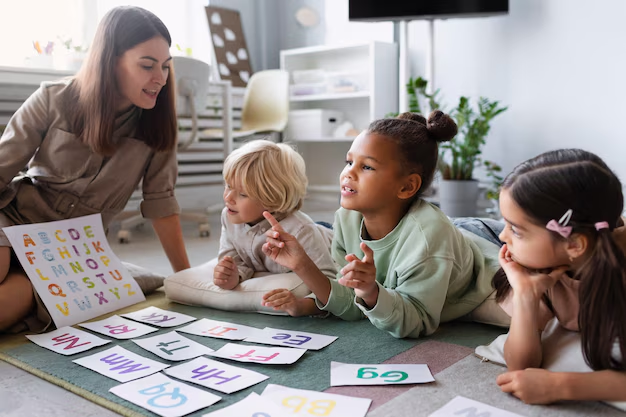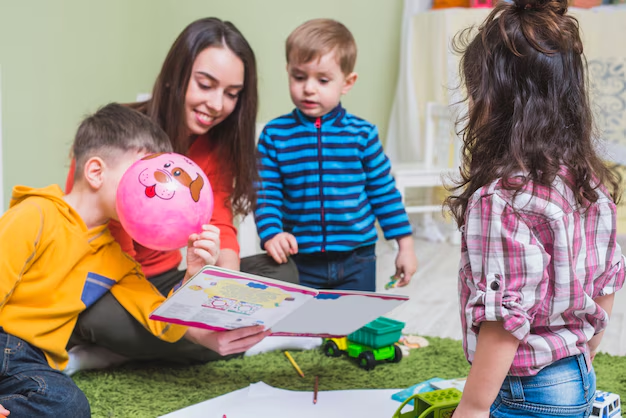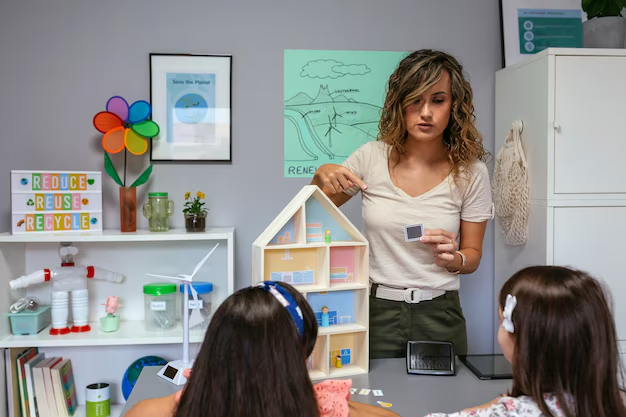The Montessori approach champions hands-on learning, letting children learn by doing something with their already learned information and activated senses. Children learn to observe, classify, and comprehend the information around them through specially designed materials.
Dr. Maria Montessori advocated that children’s best form of learning is through their senses. This is why children in Sensorial Montessori Education classrooms are taught using objects meant to improve the rate of perception by a child’s sight, touch, taste, smell, hearing, and even basic and thermic perception.
The same instructions form the core of all mathematics, language, and reasoning learning in the later stages of elementary schooling. Sensorial Education Montessori’s Education philosophy helps children understand their surroundings and develop concentration, self-direction, and problem-solving skills using engaging materials and activities.
In this essay, we will examine Sensorial Education Montessori and its advantages and differences from other forms of learning. As soon as parents, teachers, and other guardians discover the importance of focused learning at young ages, they will cherish it more.
What are the key elements of sensory education in Montessori?
French speakers would call it les Cinq Sens, but we know it as Sensory Education in Montessori. It is built upon the key components of developing sensory interplay and intelligence, essential for adult critical thinking and problem-solving.
- Visual Perception: Activities like geometric solids and color tablets help with visual discrimination, such as differentiating shapes, colors, and sizes.
- Tactile Perception: Touch boards and fabrics help children understand temperatures and textures.
- Auditory Perception: Sound cylinders and bells train the child to listen to different sounds of varying tones and volumes, supporting language and music development.
- Olfactory And Gustatory Perception: Smelling jars and tasting activities help with scent and flavor learning and improve sensory awareness.
- Baric, Thermic, and Stereognostic Perception: Baric tablets, thermodynamic bottles, and mystery bags help distinguish weight, temperatures, and forms.
These components enhance children’s cognitive faculties, equipping them with a sharpened perception of the environment.
In what ways does Sensorial Education Montessori impact child development?
Montessori Education develops a child’s upbringing through Sensory activities. It engages the child in experiences that will form the foundation of their academic and social skills later in life.
Moving on to some of the bigger benefits.
- Enhancing Cognitive Development: Children performing sensory exercises often have improved memories, problem-solving skills, neural connections, and logic.
- Enhancing Focus and Concentration: Participation in various detail-oriented Sensory activities requires attentive effort from the child but assists in developing their concentration.
- Increasing Self-Dependency: The Montessori Education approach motivates children to learn at their own pace and in their own manner, enabling them to become more self-dependent.
- Academic Preparation: Developing pattern recognition and spatial awareness through sensorial activities is the basis for more intricate subjects like language and mathematics.
- Deepening Creativity and Imaginativeness: Children’s curiosity and creativity are stimulated when they work with various colors, textures, and sounds.
The benefits of Sensorial Education in Montessori Education go beyond early childhood. It enables children to become balanced learners with a great appreciation for their surroundings.
How does Sensorial Education Montessori compare with normal education?
Like normal education, Sensory Montessori Education emphasizes the value of experiential or hands-on learning instead of rote learning.
Firsthand Experience Engaging the senses is enabled by providing children with tangible materials, unlike traditional classrooms that only use textbooks and verbal instructions.
Unlike conventional classrooms that follow a strict syllabus, Montessori Education children learn how to actively pursue their interests, which allows them to understand better.
Sensorial Education Montessori differs from other traditional forms of education. It promotes touch, hearing, and sight rather than focusing deeply on reading and listening in class, as most places do.
Montessori promotes individual learning. Unlike in a traditional classroom that follows a set curriculum, students can learn in an environment that best suits them.
Montessori aims to encourage learners and foster independence through the self-paced overcoming of concepts.
In contrast, traditional education tends to use strict examinations to obtain knowledge, while Montessori items aim to encourage children to explore and learn.
Because of this unique approach, most concepts learned through Sensorial Education Montessori are longer lasting and have a deeper understanding.
What Role Do Montessori Materials Play in Sensorial Education?
Sensorial education Montessori uses Montessori Education materials to help children refine their senses through hands-on experience and active learning.
- Pink Tower: Helps develop visual discrimination and coordination by arranging cubes in ascending order.
- Color Tablets: Teach color recognition and visual differentiation.
- Sound Cylinders: Enhance auditory discrimination by identifying matching sounds.
- Thermic Bottles: Develop sensitivity to temperature variations.
- Smelling Jars: Encourage children to pair different scents while refining their olfactory perception.
These materials make learning fun, letting children cultivate important sensory skills in a relaxed setting.
How can you assist kids with Sensorial Education Montessori while at home?
Parents can do activities that require using senses to strengthen Sensorial Education Montessori concepts at home.
- Encourage Outdoor Activities: Nature walks help children experience new feelings, listen to new sounds, and smell new scents.
- Encourage Sensory Activities: Water, sand, and sensory bins are great ways to engage multiple senses.
- Use Montessori Toys: Provide wooden puzzles, texture boards, and musical instruments to enhance sensory development.
- Activity In The Kitchen: Let children smell, taste, and touch numerous ingredients to enhance their sensory skills.
- Daily Life Skills: Activities such as sorting items, folding clothing, and pouring water improve motor and sensory skills.
With these activities put into practice, parents can offer Montessori-inspired learning, enabling Sensorial Education Montessori while at home.
Conclusion
Sensorial education Montessori enables a child’s growth to reach its full potential by promoting enhancing motor, cognitive, and sensory abilities. Multi-sensory learning facilitates Montessori children’s learning with creatichildren’suilds an independent mindset and also suffices for lifelong education.
FAQ’s
What exactly is Sensorial Education Montessori?
This branch of education centers on increasing a child’s perception and creative ability through a focused approach to the senses.
In what ways is this branch of education important for Montessori children?
Sensorial education Montessori facilitates multidimensional growth and ensures efficient learning via the practical approach.
What materials are involved in Sensorial Education Montessori?
Children are taught using the pink tower, sound cylinders, and smelling jars.
What distinguishes Sensorial Education Montessori from traditional approaches?
Traditional methods focus on passive instruction, which drills information into a student, whereas Montessori emphasizes hands-on experiences.
Can parents practice sensor education in Montessori at home?
Indeed, through sensory activities, outdoor activities, and real-life situations.



